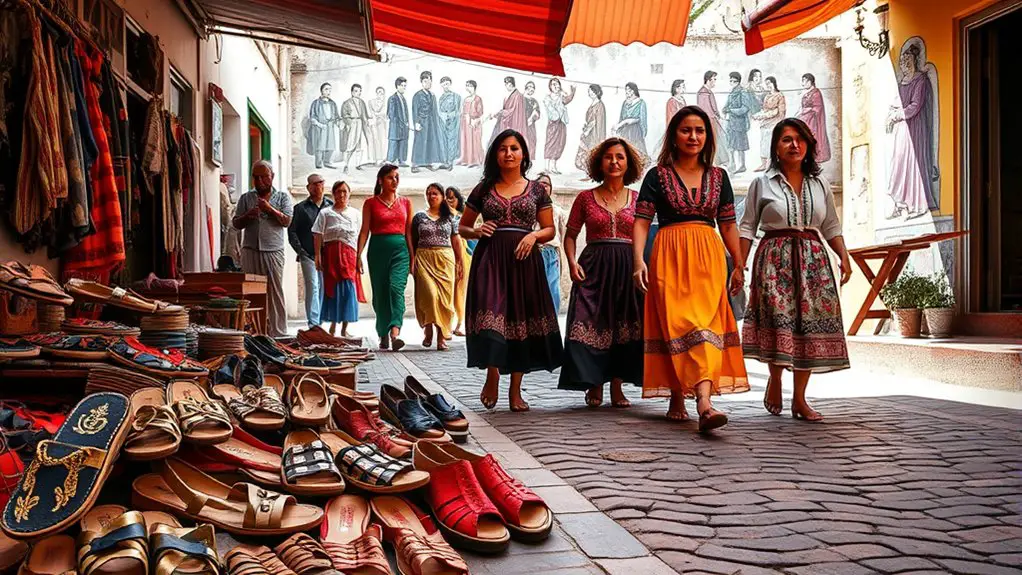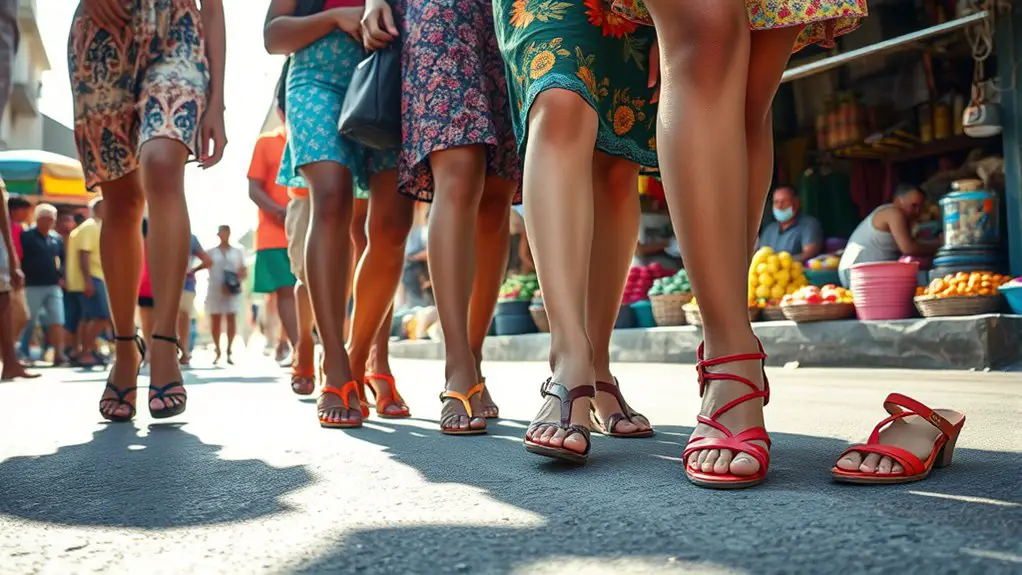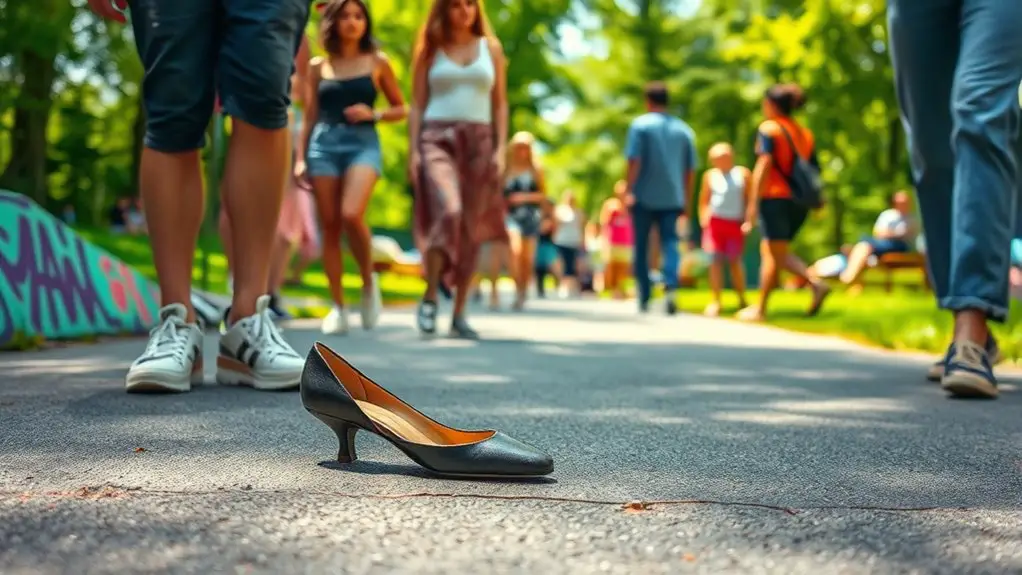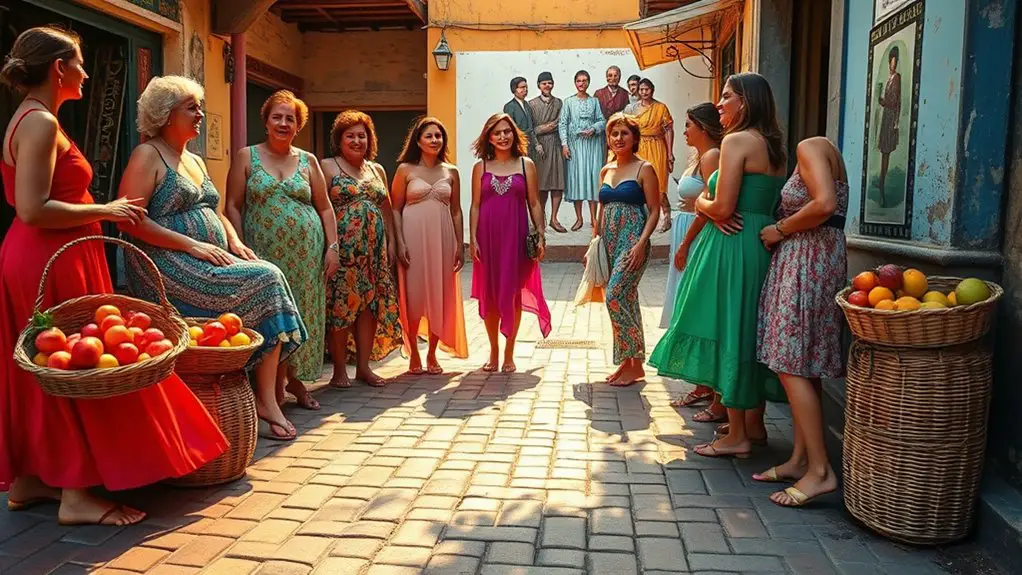Many cultures avoid high heels due to their links with discomfort and health issues. In some societies, practicality takes precedence over traditional beauty norms, promoting comfort instead. Harsh climates also influence footwear choices, favoring sturdier options. Gender roles further impact perceptions, with a tendency to prioritize autonomy over societal expectations. This complex interplay of factors highlights a growing trend towards valuing personal well-being and functionality over aesthetics, revealing deeper insights into fashion choices and cultural attitudes.
Historical Context of High Heels

High heels have a fascinating history that spans several centuries, with their origins dating back to the 10th century. Initially worn by Persian cavalry to secure their feet in stirrups, these shoes quickly gained historical significance as symbols of status and power. In Europe, by the 17th century, high heels became fashionable among aristocrats, reflecting wealth and sophistication. You might be surprised to learn that both men and women embraced these elevated shoes, showcasing their ancient origins as an integral part of elite attire.
As time passed, high heels evolved, intertwining with societal norms and gender roles. They shifted into symbols of femininity, often linked to beauty and desirability. This transformation highlights how footwear can embody cultural values, illustrating the complex relationship between fashion and identity throughout history. Understanding this context can deepen your appreciation for high heels beyond mere aesthetics, revealing their rich historical tapestry.
Cultural Norms and Values
While many might view high heels solely as a fashion statement, they actually reflect deeper cultural norms and values that shape perceptions of femininity and societal expectations. In cultures that prioritize traditional gender roles, high heels often symbolize a woman’s adherence to these expectations, suggesting elegance and desirability. This cultural significance can pressure women to conform, often leading to discomfort and health issues.
Conversely, in societies where practicality and comfort are valued, high heels may be shunned, seen as unnecessary or even impractical. Here, cultural norms promote a more egalitarian view of footwear, aligning with broader values of gender equality and functionalism. You might notice how these contrasting attitudes reveal the complexities of identity, status, and choice. Ultimately, high heels serve not just as footwear but as a lens through which we can examine the evolving landscape of societal expectations and cultural values worldwide.
The Impact of Climate on Footwear Choices

As weather conditions shift dramatically across the globe, your choice of footwear often reflects the climate you live in, influencing both practicality and style. In regions with harsh climate conditions, such as extreme cold or heavy rainfall, sturdy, waterproof boots become essential. Here, high heels may seem impractical and even hazardous. Conversely, in warmer climates, lighter materials and open-toed designs prevail, allowing for breathability and comfort.
Weather patterns also dictate cultural preferences; for instance, places with a strong affinity for outdoor activities might favor sneakers or sandals over more formal styles. This adaptability not only showcases the functionality of footwear but also highlights how cultural identity intertwines with climate. Ultimately, your footwear choices are a reflection of how you navigate your environment, balancing aesthetic desires with the realities of daily life in your specific climate.
Gender Roles and Expectations
When you think about high heels, it’s hard to ignore the weight of traditional gender norms that shape their use. In professional settings, these shoes often symbolize an expectation for women to present themselves in a certain light, blending empowerment with pressure. Additionally, the cultural significance of footwear reflects broader societal views on femininity and status, influencing how you perceive and choose your own style.
Traditional Gender Norms
Though traditional gender norms often dictate distinct roles for men and women, high heels have emerged as a powerful symbol of femininity and societal expectations. These norms shape how you express your gender and cultural identity, often linking femininity to beauty and elegance. In many cultures, high heels are perceived as a necessity for women, reinforcing their roles while simultaneously constraining their comfort and movement.
- They symbolize societal pressure to conform to beauty standards.
- They can limit mobility and physical freedom.
- They perpetuate the notion of women needing to appear attractive for validation.
- They reflect broader cultural narratives about femininity and power.
Understanding these dynamics reveals the complex relationship between high heels, gender expression, and cultural identity.
Professional Attire Expectations
While many workplaces promote a culture of professionalism, the expectations surrounding attire often reinforce traditional gender roles, particularly for women. In many settings, you’re expected to wear high heels as part of your professional attire, subtly signaling a hierarchy that prioritizes feminine aesthetics over comfort and practicality. These cultural expectations dictate that women’s competence is tied to their appearance, making it difficult to challenge the status quo. Conversely, men are often granted more freedom in their attire, typically opting for flat, practical shoes. This discrepancy highlights the underlying bias in professional environments, where attire choices reflect not just identity but also power dynamics. By conforming to these norms, you may inadvertently perpetuate a cycle of inequality in the workplace.
Cultural Symbolism of Shoes
Shoes often serve as powerful symbols of gender roles and societal expectations, with their design and style reflecting deeper cultural narratives. You might notice how shoe symbolism varies greatly across cultures, with specific styles carrying significant weight regarding identity and status.
- High heels often signify femininity and seduction.
- Sneakers can represent freedom and casualness, breaking traditional molds.
- Traditional footwear, like sandals, may symbolize cultural heritage and community ties.
- Stilettos can embody ambition and power in professional settings.
Understanding the cultural significance of these shoes can help you recognize how they influence perceptions of gender and societal norms. Ultimately, the choice of footwear goes beyond aesthetics, resonating with powerful messages about identity and expectation.
Health Concerns Associated With High Heels
When you slip on a pair of high heels, you might feel stylish and confident, but those shoes can come with serious health drawbacks. Prolonged wear can lead to foot health issues, such as bunions and plantar fasciitis, while also affecting your posture and balance. It’s crucial to evaluate how these fashionable choices impact your overall well-being and mobility.
Foot Health Issues
High heels might elevate your style, but they can also bring a host of foot health issues that you shouldn’t overlook. Wearing them regularly can lead to significant discomfort and long-term effects on your feet.
- Foot pain from inadequate arch support
- Mobility issues due to joint strain
- Circulation problems that may arise over time
- Comfort preferences can suffer as a result
These concerns underscore the necessity of considering alternative footwear. Choosing shoes that prioritize comfort and health can help mitigate potential risks, allowing you to maintain your style without sacrificing your well-being. It’s crucial to listen to your body and be aware of how high heels can impact your overall foot health in the long run.
Posture and Balance Risks
Wearing high heels can greatly disrupt your posture and balance, leading to a range of health concerns. These stylish shoes often cause misalignment in your posture, putting excessive strain on your spine and joints. As you teeter on high heels, you face balance challenges that can lead to falls and injuries.
| Posture Alignment Issues | Balance Challenges |
|---|---|
| Increased lumbar curve | Difficulty walking straight |
| Misaligned hips | Higher risk of ankle sprains |
| Tension in calf muscles | Dizziness and instability |
Over time, these issues can result in chronic pain and discomfort, making it essential to reflect on the long-term effects of your footwear choices on your overall health.
The Rise of Casual Fashion

As fashion evolves, you might notice a significant shift towards casual styles, reflecting deeper societal changes in attitudes and lifestyles. The rise of casual fashion emphasizes casual comfort and relaxed attire, resonating with your desire for practicality in daily life. This movement isn’t just a trend; it’s a cultural transformation that champions self-expression and individuality.
- The increasing importance of lifestyle over rigid dress codes.
- A growing preference for versatile pieces that adapt easily from work to leisure.
- The influence of tech and remote work on everyday clothing choices.
- A shift towards sustainable fashion, favoring comfort and function.
As you embrace this era of casual fashion, you’ll find that it encourages a more authentic connection to your personal style. The focus on relaxed attire not only enhances comfort but also fosters a sense of freedom, allowing you to navigate your day with ease and confidence.
Practicality Over Aesthetics
The shift toward casual fashion naturally leads to a reevaluation of the role of practicality in clothing choices. As you navigate daily life, you likely find that functionality preferences often take precedence over aesthetics. High heels, once a symbol of elegance, may now feel cumbersome compared to comfortable alternatives that allow for ease of movement.
In cultures where comfort prioritization is essential, it’s clear that style shouldn’t compromise your well-being. You might prefer sneakers or flat shoes that support your feet during long hours on the go. This practicality aligns with a broader societal trend that values comfort over superficial glamor.
As you consider your wardrobe, you might ask yourself: Do these shoes enhance my daily experience, or are they merely a fashion statement? Ultimately, embracing practicality can lead to a more enjoyable and fulfilling way of dressing, reflecting a shift in cultural attitudes toward footwear.
Economic Factors Influencing Footwear Choices
While many people may long for the elegance of high heels, economic factors often dictate what options are truly viable for everyday wear. In societies marked by economic disparities, consumer preferences lean towards practicality and affordability. High heels, often seen as a luxury, can be less accessible to those facing financial constraints.
- The cost of quality footwear can be prohibitive for lower-income individuals.
- Alternative styles, like sneakers or flats, often provide better comfort and durability.
- Cultural norms may prioritize functionality over fashion in economically challenged regions.
- Economic stability influences fashion trends, making high heels less appealing in struggling economies.
As a result, footwear choices reflect not just personal taste but also the broader economic context, shaping what’s deemed appropriate or desirable for daily life. Understanding these factors can help you appreciate why high heels aren’t universally embraced.
Symbolism of Footwear in Different Societies
Footwear often carries deeper meanings beyond mere practicality, reflecting cultural identities and societal values. In many societies, the symbolism of footwear can reveal a lot about social status, gender roles, and cultural beliefs. For instance, in some cultures, traditional sandals signify a connection to heritage and community, while high heels might symbolize modernity and femininity in others.
When you think about it, every choice in footwear can be a statement about who you are. In cultures that prioritize modesty, closed-toed shoes may dominate, conveying respect and restraint. On the other hand, in more individualistic societies, bold styles can express personal identity and freedom.
As you explore different cultures, consider how footwear symbolism intertwines with cultural identity, shaping not just fashion but also the way people perceive themselves and each other. Ultimately, your shoes might tell a story far deeper than you’d expect.
The Influence of Globalization on Fashion Trends
As global connectivity increases, fashion trends have become a melting pot of influences, reflecting a rich tapestry of cultures and styles. You might notice how this global fashion convergence shapes what you wear, blending traditional elements with contemporary flair. However, this fusion isn’t without its challenges.
- The rise of social media accelerates the spread of styles worldwide.
- Western fashion often dominates, overshadowing local traditions.
- Cultural appropriation concerns arise when elements are borrowed without understanding their significance.
- A balance between appreciation and exploitation becomes vital.
These factors complicate your understanding of fashion. As you navigate this landscape, it is important to recognize how globalization can both enrich your wardrobe and spark debates about authenticity and respect. By being mindful of these dynamics, you can appreciate diverse influences while honoring their origins, fostering a more inclusive fashion culture.
Frequently Asked Questions
How Do High Heels Affect Women’s Confidence in Different Cultures?
They say, “Beauty is in the eye of the beholder.” In different cultures, high heels can elevate confidence levels, yet cultural perception shapes how women embrace or reject them, influencing self-esteem and societal expectations profoundly.
Are There Specific Rituals or Ceremonies Where High Heels Are Avoided?
In many cultures, traditional events emphasize comfort over style, avoiding high heels. These choices often reflect cultural symbolism, valuing practicality and groundedness, which enhance community connection and respect for rituals instead of focusing solely on individual appearance.
What Role Do Local Fashion Designers Play in High Heel Trends?
Local fashion designers are like wizards, conjuring unique trends through innovative designs. Their creations reflect local influences, shaping high heel styles that resonate deeply with cultural identities while pushing boundaries, making fashion a vibrant canvas for expression.
How Do Age Demographics Influence High Heel Acceptance in Various Cultures?
Age demographics greatly shape high heel acceptance; youth preferences often lean towards trendy, bold styles, while older generations may prioritize comfort. These generational attitudes create a fascinating dialogue on fashion’s evolution within different cultural contexts.
Are There Any Notable Exceptions to Cultures That Typically Avoid High Heels?
You’ll find fascinating cultural exceptions where high heel symbolism shines brightly, often in fashion-forward urban areas. In these spaces, heels represent power and prestige, contrasting with traditional norms while celebrating individuality and style in unexpected ways.



